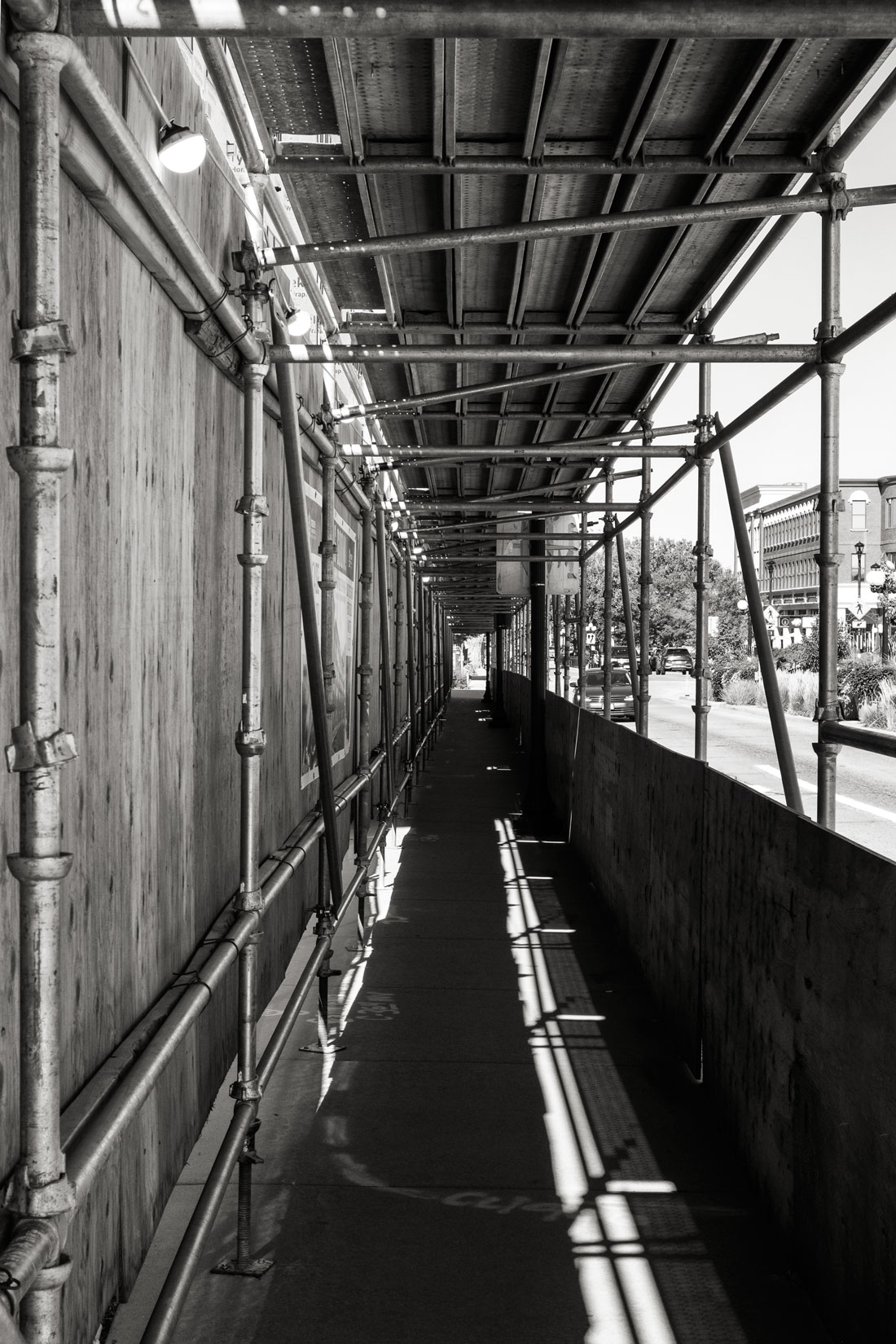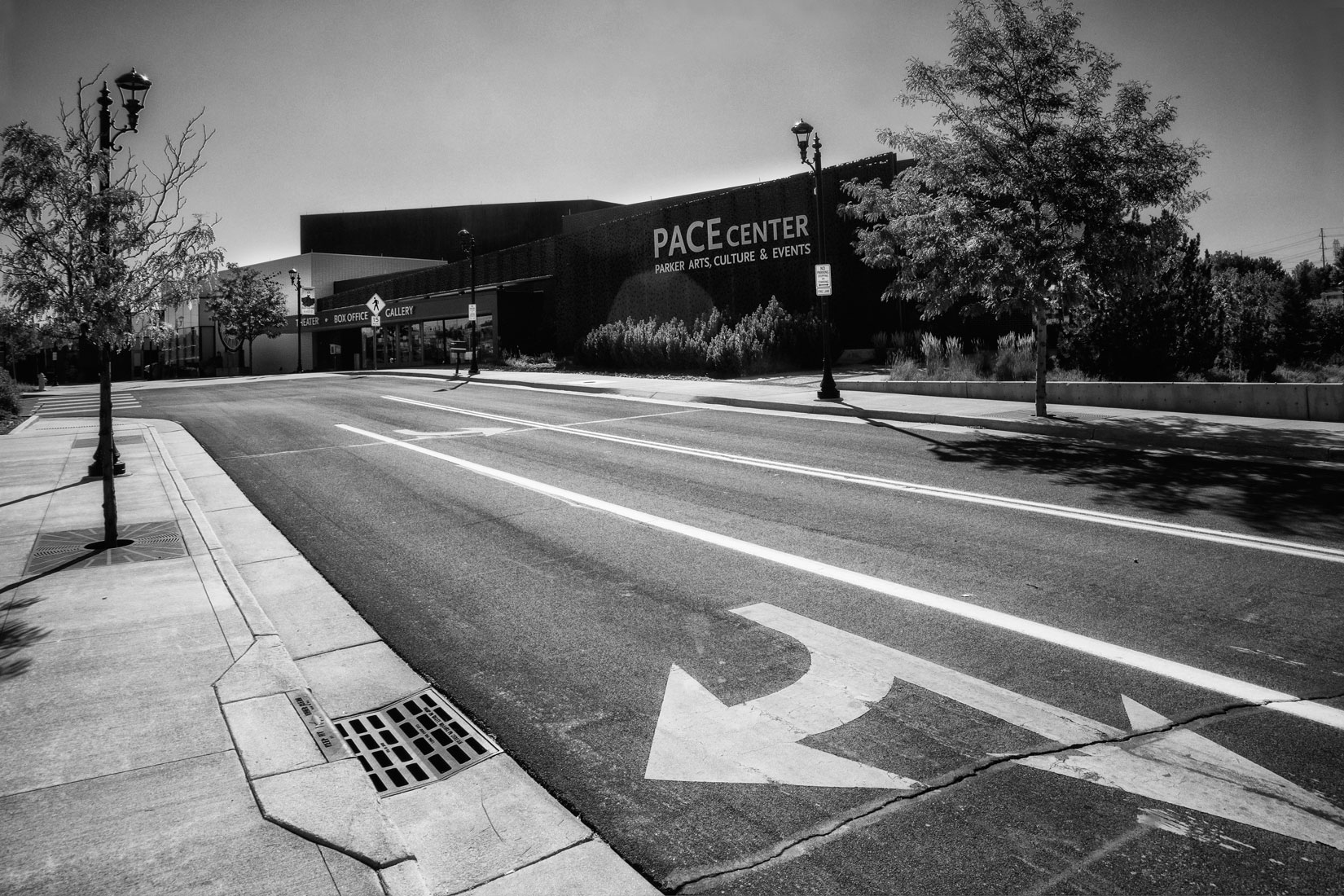Today’s Post by Joe Farace
“In every walk with nature, one receives far more than he seeks.” — John Muir
Continuing my series of monochrome PhotoWalks…On Labor Day, I headed to uptown in Parker, Colorado and took along a Canon EOS M6 Mark II with EF-M15-45mm f/3.5-6.3 IS STM lens. This is a camera I mostly use to make videos for my YouTube channel and seldom use to make still images but it’s a really versatile hybrid camera and I wanted to see how it did.
Going Uptown
 After driving and parking at the PACE fine arts performance center, I realized that had I made a big mistake, one that plagued me when shooting the Olympus Pen EP-3 on my last PhotoWalk.
After driving and parking at the PACE fine arts performance center, I realized that had I made a big mistake, one that plagued me when shooting the Olympus Pen EP-3 on my last PhotoWalk.
It was a bright, sunny day and I didn’t bring an eye-level finder. But, Mr. Bill, I actually own the camera’s (optional) EVF-DC2 finder that features a 0.39-inch 2.36m-dot OLED display. Where was it? Sitting in a Waterford ashtray on my desk, along with a bunch of paperclips— I quite smoking 40 years ago. The EOS M6 Mark II has a three-inch, 1.04-million-dot LCD screen and using it was batter than nothing. I mostly tried to shoot in the shade of the crabapple trees planted alongside the sidewalk next to the PACE Center. Oh yes, I brought my cane but left it in the car, in case…
I was shooting in RAW+JPEG mode giving me a black and white JPEG file with a preview of the monochrome image on my LCD screen along with a color .CR3 RAW file that, later on, I discovered wouldn’t open in Adobe Camera RAW CS6. To fix the impasse, I used Adobe DNG Converter and easily converted the .CR3’s into more portable DNG files that I could open with my older version of Photoshop. No subscriptions required.
How I Made this Photograph: I was shooting RAW+JPEG and producing monochrome JPEG and color RAW files and decided to try an experiment with this image. I opened the monochrome JPEG image first, than opened its twin color DNG file and processed it quickly in Silver Efex and compared the results. I decided I liked my converted black and white image better so that’s what you see here.
The original image made with Canon EOS M6 Mark II and EF-M15-45mm f/3.5-6.3 IS STM lens at 35mm. When shooting this scene, I tried using different focal lengths and liked this one the best. Exposure was 1/250 sec at f/10 and ISO 400. The image was slightly rotated to accommodate my OCD tendencies and slightly cropped before processing using Silver Efex’s High Structure (smooth) preset. I added a thin layer of Platinum toning from PhotoKit to add a little pseudo Agfa Portriga look, my old favorite printing paper back in my (wet) darkroom days.

How I Made this Photograph: This image was made outside the PACE fine arts and performance center where Vala the Artist had recently exhibited her work. It was made with my Canon EOS M6 Mark II and EF-M15-45mm f/3.5-6.3 IS STM lens at 55mm and perspective corrected because, you know…and slightly cropped to bring it back into the 3:2 aspect ratio. The DNG file was processed into black and white using Silver Efex and then layered with the Glamour Glow filter that’s part of Color Efex,
About the Canon EOS M6 Mark II: This camera was Canon’s first and halfhearted attempt at building a mirrorless camera. In fact they build several cameras in the series. Unlike Nikon’s unloved 10.1-megapixel 1 Series mirrorless cameras that used a 13.2 x 8.8mm sensor—about half the size of the Micro Four-thirds —Canon’s M series cameras used a larger APS-C (22.3 × 14.9 mm) sensor. That is not to say that the 1 Series doesn’t have its fans. Mary loves shooting her Nikon V1, calling it her “art camera” and it’s her first choice when traveling because of its compact size.
The 32.5-megapixel EOS M6 Mark II uses a propriety EF-M mount and Canon never made many lenses for it. Yet Sigma produced a series of three prime lenses— 16mm, 30mm and 56mm—all at f/1.4 apertures. They were great but not cheap; use the blog’s search function to find my tests of each lens. While both Nikon and Canon’s first mirrorless cameras were neglected by their manufactures, the Canon M-series models were widely beloved, especially by hybrid shooters. Last October, Canon officially discontinued the M-series, but even today, refurbished Canon EOS M6 Mark II cameras (with a lens) are selling online for more than a thousand bucks! By comparison, Canon’s cheapest new R-series mirrorless hybrid camera, the R50, is selling for $690 with a lens. What does that tell you? More interesting what does it tell Canon? I’m betting not much.
If you enjoyed today’s blog post and would like to buy me to a cup of Earl Grey tea ($3.50,) please click here. And if you do, thanks so much.